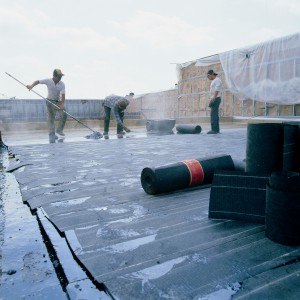|
What makes a good roof?
It depends on your needs, budget, expectations and, ultimately, your decision.
Choosing the correct roofing system will determine your long-term satisfaction with your decision and your new roof. When you request a quote, we will evaluate your roofing needs and explain your options thoroughly. If you are serious about choosing the right roofing system, we are confident that we are the right team of professionals for you.
We encourage you to review the follow roofing systems to gain a better understanding of available options. Then, give us a call to learn how we can help with your needs and concerns.
 BUILT-UP ROOF (BUR) BUILT-UP ROOF (BUR)
BUR is an old generic term for any system that is composed of multiple layers of felt that are adhered together with either hot asphalt, cold asphalt or coal tar pitch. BUR roofing can be applied in many different configurations. The traditional BUR assembly consists of four plies of felt set in solid mopping of interply bitumen. There are also configurations consisting of a base ply of twenty-eight pound base felt with three plies of felt all set into a solid interply mopping of bitumen.
Traditional Built Up Roofing and Cold Applied Built Up systems are optionally surfaced with an aggregate, finishing felt or coating as recommended by the system's manufacturer.
MODIFIED BITUMEN ROOFING (MODIFIED)
Modified systems are available in several different varieties, but typically APP (torch applied) and SBS (hot applied with bitumen or torch applied) are utilized. A Modified Bitumen System can be installed as a single layer or multi-ply system. Modified systems are reinforced with either fiberglass or polyester scrim. The finished membrane can be either left smooth, surfaced with aggregate or granule, foil faced from the factory, or coated.
SINGLE PLY MEMBRANE ROOFING
Single Ply roof systems are generally those that are factory fabricated and installed in the field as a single layer. The product typically comes in a roll and can be installed loose-layered, fully adhered, mechanically attached, or ballasted. The laps of these systems are glued together with adhesive, chemically welded or heat welded. These types of systems offer ease of installation, typically lighter weight, usually a lower cost because of labor installation savings. Some concerns about these types of systems are puncture resistance, ponding water, and chemical resistance.
EHTYLENE PROPYLENE DIENE MONOMER ( EPDM )
EPDM is a membrane that is a rubber that has an additive to provide tensile strength. In black EPDM, the major additive is carbon black. Black EPDM is one of the least expensive systems to produce and install, and accounts for more than half of the single ply market. EPDM membrane is available in very large sheets, therefore the quick installation of large roof areas is possible. EPDM membrane is available in several thicknesses and can be reinforced with a polyester scrim.
POLYVINYL CHLORIDE ( PVC)
PVC is a membrane that is a thermoplastic material available in a variety of thicknesses and optional reinforcements. Like most single ply systems, the material can be formed into many different shapes and conditions by utilizing heat and adhesives. PVC membranes in the past have been prone to plasticizer migration and the product should be monitored.
CLORINATED POLYETHYLENE (CPE)
CPE is a membrane consisting of polyethylene that has been chlorinated to increase fire resistance. The CPE membrane is an uncured membrane that does not utilize a plasticizer to achieve an elastomeric or flexible quality. The CPE membrane is heat welded during its installation to provide a strong welded seam.
CHLOROSULPHANATED POLYETHYLENE - HYPALON ( CSPE)
CSPE is a membrane that has the same characteristics of CPE membrane with the following difference. A sulfur is added to improve the weathering ability and the membrane begins to cure after exposure to the elements. This product, if not properly installed, has a tendency to give the installer a false weld at the seam location. Probe should be taken of the seam and flashing locations after the installation is complete to insure proper welds.
POLYISOBUTYLENE ( PIB )
PIB is a membrane that is composed of Polyethylene, Isobutylene, fillers and a polyester fleece backing. This membrane is manufactured in a roll form and has a self-adhesive lap. The installation method of this system often utilizes hot asphalt as its adhesive, which provides a strong bond to the substrate.
|